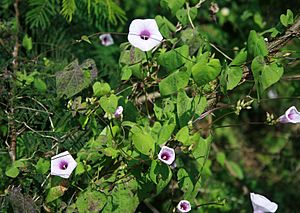Threefork morning glory facts for kids
Quick facts for kids Threefork morning glory |
|
|---|---|
 |
|
| Scientific classification | |
| Genus: |
Ipomoea
|
| Species: |
trifida
|
| Synonyms | |
|
|
Ipomoea trifida, also known as the threefork morning glory, is a type of flowering plant. It belongs to the Convolvulaceae family, which includes many kinds of morning glories. This plant naturally grows in the Caribbean, Mexico, and South America.
Ipomoea trifida is very special because it is the closest wild relative to the common sweet potato (Ipomoea batatas). Scientists believe these two plants separated from a common ancestor about 800,000 years ago. Unlike the sweet potato, the roots of I. trifida are thin and cannot be eaten. Its flowers are usually a pretty purple color.
Contents
What is the Threefork Morning Glory?
The threefork morning glory is a plant that grows in warm, sunny places. It is a vine, meaning it climbs or spreads along the ground. Its name, "trifida," comes from Latin and means "three-parted," which might refer to the shape of its leaves.
Where Does It Grow Naturally?
This plant is native to several parts of the world. You can find it growing wild in the Caribbean islands. It also thrives in Mexico and many countries in South America. It prefers tropical and subtropical climates.
How Does It Look?
The threefork morning glory has beautiful purple flowers. These flowers often look like small trumpets. Its leaves can vary in shape, but they are typically green. The plant grows roots, but these roots are not like the big, edible sweet potatoes we eat. Instead, they are thin and stringy.
Why is Ipomoea trifida Important?
Ipomoea trifida is very important to scientists. It helps us understand how the sweet potato came to be. By studying its wild relatives, researchers can learn more about the sweet potato's history. This knowledge can help improve sweet potato crops for food.
How is it Related to Sweet Potatoes?
Scientists use genetic studies to understand plant relationships. They have found that Ipomoea trifida shares a lot of its DNA with the sweet potato. This makes it the closest wild plant to the sweet potato. Studying I. trifida can help scientists find new traits. These traits could make sweet potatoes stronger or more resistant to diseases.
What Can We Learn from Wild Relatives?
Wild relatives of crops are like a treasure chest of genetic information. They often have genes that help them survive in harsh conditions. For example, they might be resistant to certain pests or diseases. By studying Ipomoea trifida, scientists hope to find these useful genes. They can then use them to breed better sweet potato varieties. This helps ensure we have enough food for everyone.
Images for kids


